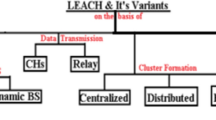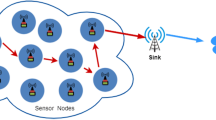Abstract
Clustering techniques are employed to optimize energy consumption corresponding to different node activities and thus to conserve the limited energy of the sensor nodes. Different locations and different loads cause unbalanced energy consumption in the network nodes, consequently, the network lifetime is shortened. In this paper, a clustering method to improve energy conserving and to balance the energy consumption of cluster head is proposed. The area and the dimensions of the clusters are calculated by the algorithm in such a way that the rates of energy consumption of all the cluster heads be equalized. Also, all the intra-cluster communications are performed in single hop manner. The proposed approach presents a solution for the challenge of short lifetime of heavy burdened cluster heads around the base station. A straightforward routing scheme is proposed corresponding to the proposed clustering model to deliver the data sensed by cluster members to the base station. The performance evaluations indicate that the proposed method not only prolongs more effectively the lifetime of both cluster heads and cluster members than the other works, but also, outperforms them in balancing the energy level of the cluster heads. Consequently, the duration of activity of the cluster members in different clusters is also balanced and prolonged. Moreover, the proposed method improves the network throughput, comparing with the other works.













Similar content being viewed by others
References
Fahmy HMA (2016) Wireless Sensor Networks: Concepts, Applications, Experimentation and Analysis, 1st edn. Springer, Berlin
Curry RM, Smith JC (2016) A survey of optimization algorithms for wireless sensor network lifetime maximization. Comput Ind Eng 101:145–166
Rostami AS, Badkoobe M, Mohanna F, Keshavarz H, Hosseinabadi AAR, Sangaiah AK (2018) Survey on clustering in heterogeneous and homogeneous wireless sensor networks. J Supercomput 74(1):277–323
Fei Z, Li B, Yang S, Xing C, Chen H, Hanzo LH (2017) A survey of multi-objective optimization in wireless sensor networks: metrics, algorithms, and open problems. IEEE Commun Surv Tutorials 19:550–586
Roselin J, Latha P, Benitta S (2017) Maximizing the wireless sensor networks lifetime through energy efficient connected coverage. Ad Hoc Netw 62(C):1–10
Kulshrestha J, Mishra M (2017) An adaptive energy balanced and energy efficient approach for data gathering in wireless sensor networks. Ad Hoc Netw 54(C):130–146
Cenedese A, Luvisotto M, Michieletto G (2017) Distributed clustering strategies in industrial wireless sensor networks. IEEE Trans Ind Inf 13(1):228–237
Nayak P, Vathasavai B (2017) Energy efficient clustering algorithm for multi-hop wireless sensor network using type-2 fuzzy logic. IEEE Sensors J 17(14):4492–4499
Huang J, Hong Y, Zhao Z, Yuan Y (2017) An energy-efficient multi-hop routing protocol based on grid clustering for wireless sensor networks. Clust Comput 20(4):3071–3083
Moon SH, Park S, Han SJ (2017) Energy efficient data collection in sink-centric wireless sensor networks. Comput Commun 101(C):12–25
Ari AAA, Yenke BO, Labraoui N, Damakoa I, Gueroui A (2016) A power efficient cluster-based routing algorithm for wireless sensor networks: Honeybees swarm intelligence based approach. J Netw Comput Appl 69:77–97
Hoang DC, Yadav P, Kumar R, Panda SK (2014) Real-time implementation of a harmony search algorithm-based clustering protocol for energy-efficient wireless sensor networks. IEEE Trans Ind Inf 10(1):774–783
Kuila P, Jana PK (2014) Energy efficient clustering and routing algorithms for wireless sensor networks: Particle swarm optimization approach. Eng Appl Artif Intell 33:127–140
Phanish D, Coyle EJ (2017) Application-based optimization of multi-level clustering in Ad Hoc and sensor networks. IEEE Trans Wirel Commun 16(7):4460–4475
Lan KC, Wei MZ (2017) A compressibility-based clustering algorithm for hierarchical compressive data gathering. IEEE Sensors J 17(8):2550–2562
Hu Y, Niu Y, Lam J, Shu Z (2017) An energy-efficient adaptive overlapping clustering method for dynamic continuous monitoring in WSNs. IEEE Sensors J 17(3):834–847
Oladimeji MO, Turkey M, Dudley S (2017) HACH: Heuristic Algorithm for clustering hierarchy protocol in wireless sensor networks. Appl Soft Comput 55:452–461
Mann PS, Singh S (2017) Energy efficient clustering protocol based on improved metaheuristic in wireless sensor networks. J Netw Comput Appl 83:40–52
Azharuddin M, Jana PK (2017) PSO-Based approach for energy-efficient and energy-balanced routing and clustering in wireless sensor networks. Soft Comput 21(22):6825–6839
Heinzelman WB, Chandrakasan AP, Balakrishnan H (2002) An application-specific protocol architecture for wireless microsensor networks. IEEE Trans Wirel Commun 1(4):660–670
Author information
Authors and Affiliations
Corresponding author
Additional information
Publisher’s Note
Springer Nature remains neutral with regard to jurisdictional claims in published maps and institutional affiliations.
Rights and permissions
About this article
Cite this article
Alaei, M., Yazdanpanah, F. EELCM: An Energy Efficient Load-Based Clustering Method for Wireless Mobile Sensor Networks. Mobile Netw Appl 24, 1486–1498 (2019). https://doi.org/10.1007/s11036-019-01270-2
Published:
Issue Date:
DOI: https://doi.org/10.1007/s11036-019-01270-2




